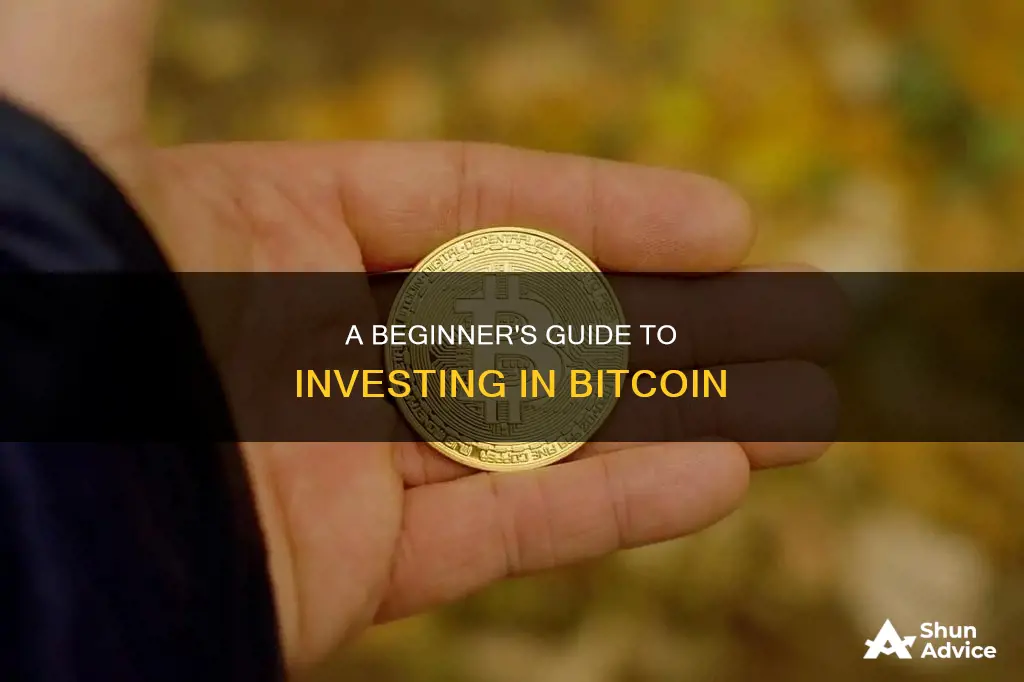
Bitcoin is a cryptocurrency that was created in 2009 by Satoshi Nakamoto. It is a virtual currency that is secured through cryptography and appears on a distributed ledger called a blockchain. Cryptocurrency investing can take many forms, from buying cryptocurrency directly to investing in crypto funds and companies. For direct investing in crypto coins, you can buy cryptocurrency using a crypto exchange or through certain broker-dealers. Once you own it, you can store, manage, and even buy or sell your crypto in a wallet.
What You'll Learn

Choosing a Bitcoin exchange
Objectives and Investment Style
Before selecting an exchange, it is important to understand your objectives and investment style. For example, are you looking to invest for the long term or trade in and out of positions regularly? If you are an investor, you might consider spot exchanges, which allow you to buy and sell actual digital assets like Bitcoin. On the other hand, if you are a trader, you might be interested in derivatives exchanges, which offer trading products such as futures and options based on the price action of underlying spot assets.
Country Regulations and Security
Different exchanges comply with varying laws and regulations based on their locations, practices, and offerings. Some exchanges have Know Your Customer (KYC) and Anti-Money Laundering (AML) practices in place, requiring participants to submit personal information during account creation. Additionally, it is crucial to assess the security measures of an exchange. Check if the exchange offers two-factor authentication (2FA) and what type of 2FA is compatible. Google Authenticator, Authy, and Yubikey are some common options that offer better security than mobile text-based 2FA.
Fiat Compatibility
At some point, you may need a fiat-compatible exchange to transfer national currencies (USD, CAD, etc.) into and out of the crypto world. Not all exchanges support the same fiat currencies and banks, so it is important to check which banks and fiat currencies are compatible with your chosen exchange.
Trading Volume and Liquidity
Trading platforms vary in terms of the number of participants and the volume of each asset being traded. This is an important consideration as it affects your ability to enter or exit positions easily. Low-volume exchanges may not have enough sellers or buyers, forcing you to accept lower or higher prices, respectively.
Supported Coins and Tokens
While most exchanges support Bitcoin and Ethereum, if you want to invest in other cryptocurrencies, you need to ensure that the exchange offers those coins and tokens. Binance, for instance, is popular because it grants traders and investors exposure to a broader range of cryptocurrencies than other platforms.
Fees
Most exchanges charge a small fee for each trade, and these fees can vary across platforms. Some exchanges also have withdrawal fees and limits. It is important to understand the fee structure of an exchange to know what to expect when conducting transactions.
User Interface and Experience
The user interface and user experience of an exchange can significantly impact your success as a trader or investor. Choose an exchange with an intuitive interface and good user experience, making it easier to trade cryptocurrencies. Additionally, consider the customer service and other customer-related functionalities offered by the exchange.
A Beginner's Guide: Investing in Bitcoin Gold in India
You may want to see also

Getting a Bitcoin wallet
Mobile Wallets
Mobile wallets are convenient and portable, making them ideal for face-to-face transactions. They are designed to use QR codes to facilitate quick and seamless transactions. However, mobile wallets are susceptible to malware, spyware, and viruses that could steal your Bitcoin. Additionally, damage or loss of the device can potentially lead to the loss of funds.
Desktop Wallets
Desktop wallets offer more security than mobile wallets, and some even support hardware wallets or can operate as full nodes. However, they are not designed for scanning QR codes, making them less mobile-friendly. Similar to mobile wallets, desktop wallets are also susceptible to malware.
Hardware Wallets
Hardware wallets are considered one of the most secure methods to store large amounts of Bitcoin. They are offline storage devices that connect to your computer when you need to manage your funds. While they provide excellent security, hardware wallets are not as convenient for mobile use. Additionally, losing the device without a proper backup can make your funds unrecoverable.
When choosing a Bitcoin wallet, it is important to consider factors such as security, ease of use, transaction fees, and backup options. It is also essential to remember that, regardless of the wallet type, you are responsible for securing and backing up your wallet.
Blackcoin: A Smart Investment Decision?
You may want to see also

Connecting your wallet to a bank account
Step 1: Access the "Add Account" Screen
On the BudgetBakers app, you can access the "Add Account" screen by swiping left on your Dashboard until you reach the end of your accounts. From there, swipe left once more to see the "Add Account" screen. Alternatively, on the "All Accounts" screen, click on the "Add Account" box in the list of accounts.
Step 2: Select "Bank Sync"
To add a bank-connected account, choose the "Bank Sync" option. This will allow you to link your bank account to your wallet.
Step 3: Provide Bank Information
Type in your bank's country and name in the search field. If you cannot find your bank, you may need to submit a request for integration. Select your bank from the drop-down field. Some platforms may refer to this as the "Premium accounts" section.
Step 4: Enter Login Credentials
Enter the login credentials you normally use to access your bank's website. Depending on your bank's security measures, you may need to answer additional security questions.
Step 5: Choose Your Account
Select the specific account you want to link from the provided options.
By following these steps, you will be able to connect your wallet to your bank account securely. Remember to keep your login credentials safe and ensure that you are using a trusted platform to protect your financial information.
It is important to note that investing in Bitcoin or any other cryptocurrency carries risks. Always do your research, understand the volatility of the market, and only invest what you can afford to lose.
A Guide to Bitcoin Investment in Uganda
You may want to see also

Placing your Bitcoin order
Once you have chosen a cryptocurrency exchange, you will need to establish an account and fund it with fiat money.
Market order
A market order is a direct buy order, which is an instruction to the broker to buy or sell a security immediately. This type of order has the highest priority and is executed immediately at the best available price. The main advantage of a market order is that it is executed immediately, making it particularly suitable when speed is of the essence. However, the execution price may differ from the expected price, especially in volatile markets, and unexpected costs may arise. Market orders cannot be cancelled because they are filled immediately.
Limit order
A limit order is an instruction to buy or sell an asset at a set price or better on the stock exchange. This type of order offers investors more control over the price and is only executed when the market value reaches or exceeds the set limit. When buying, this means that the order will only be executed at the set limit price or cheaper. A limit order is best suited for the trader who can patiently wait for a price target to be reached. However, the order may not be executed if the market price does not reach the limit.
Stop-loss order
A stop-loss order is an instruction to sell an asset when the price reaches or falls below a specified stop price. This type of order is designed to limit losses. Once the specified value is reached, the order is immediately executed as a market order, i.e. a direct buy order, at the best available price. The advantage of a stop-loss order is risk management. It ensures that a security is sold before it continues to lose value, thus limiting any losses. However, the actual selling price can be significantly lower than the set stop price in highly volatile markets.
Stop-limit order
A stop-limit order is a combination of a stop order and a limit order. It is executed as soon as, for example, the price of a security reaches a specified stop price, but only at a certain limit price or better. As soon as the stop price is reached, the stop-limit order is converted into a limit order. This is then only executed at the specified limit price or better. The advantage of a stop-limit order is the controlled execution. Investors can precisely determine the maximum acceptable loss or profit. However, stop-limit orders are more complicated than simple market or limit orders and require a good understanding of the underlying mechanisms. There is also the risk that the order will not be executed if the market price does not reach the limit.
Stop-buy order
A stop-buy order is used to buy an asset once the price reaches or exceeds a certain stop price. This is useful for entering a rising market. Once the stop price is reached, the stop-buy order is converted to a market order type and is immediately executed at the best available price. However, there is no guarantee that the order will be executed at the expected price. In volatile markets, the final purchase price can therefore differ significantly from the set stop price.
Trailing stop order
A trailing stop order is a dynamic tool for investors to automatically adjust the stop price when the market price moves favourably. It is used to lock in profits while increasing the potential for further profits. The advantage of a trailing stop order is the ability to lock in profits while maintaining the potential for further profits. In addition, this type of order automatically adapts to market movements, allowing for a flexible trading strategy. However, trailing stop orders are extremely complex and require a good overview of how the markets work and the correct setting of the trailing distance. As already explained for other order types, the final price upon execution can deviate from the desired stop price, especially in highly volatile markets.
The Ultimate Guide to Bitcoin ETF Investing
You may want to see also

Managing your Bitcoin investments
- Monitor Market Trends and Regulatory News: The cryptocurrency market is highly volatile and susceptible to various global factors. Stay updated with the latest market trends, regulatory changes, and industry news to make informed decisions. This will help you anticipate potential risks and identify opportunities for maximising your investment's potential.
- Choose a Reputable Platform: Select a reliable and user-friendly trading platform, such as Kriptomat, that offers robust security measures and is well-regarded in the crypto community. A good platform will provide you with the necessary tools to manage and track your investments effectively.
- Diversify Your Investment Strategies: Don't put all your eggs in one basket. Diversify your Bitcoin investment strategies to reduce risk and maximise returns. Consider a combination of long-term holding (HODLing), regular buying through dollar-cost averaging (DCA), and swing trading to capitalise on market shifts.
- Utilise Intelligent Portfolios: Take advantage of platforms that offer intelligent portfolio services, such as Kriptomat's Intelligent Portfolios. These services automatically manage your investments, providing data-driven investment decisions and diversified asset allocation to optimise returns while effectively managing risk.
- Start Small and Gradually Increase Exposure: As a beginner, start with small investments and gain a basic understanding of each investment strategy's risks and benefits. As you gain more knowledge and confidence in the market, you can gradually increase your exposure and explore more advanced strategies.
- Secure Your Digital Wallet: Since crypto is a digital-only asset, ensure you have a secure digital wallet to store your Bitcoin. Consider using a third-party hot wallet provider with added security measures or a cold wallet, which is an offline encrypted device. Regularly back up your wallet and store your recovery phrase in a safe place to prevent loss or theft.
- Practice Emotional Discipline: The crypto market is highly volatile, and it's easy to get caught up in the excitement or panic. Maintain emotional discipline by sticking to your investment strategy and avoiding impulsive decisions based on short-term market fluctuations.
- Regularly Review and Rebalance Your Portfolio: Periodically review your investment portfolio to assess whether you need to rebalance your crypto holdings. Depending on your investment goals and financial needs, you may need to increase or decrease your exposure to Bitcoin and other cryptocurrencies.
- Understand the Tax Implications: Cryptocurrency investments can have complex tax implications. Consult with a tax professional to understand your tax obligations and how to minimise tax liabilities. Keep detailed records of your transactions to make tax reporting easier.
- Stay Informed and Educated: The crypto space is constantly evolving, with new technologies, regulations, and investment opportunities emerging. Stay informed by following reputable crypto news sources, joining crypto communities, and seeking educational resources to make more strategic investment decisions.
- Set Clear Goals and Risk Management Strategies: Define your investment goals and risk tolerance before investing in Bitcoin. Determine how much you are comfortable investing, and set clear risk management strategies to protect your capital. Remember that Bitcoin investments are speculative, and you should only invest what you can afford to lose.
Gold Coin Investment: A Smart Move for Your Money?
You may want to see also
Frequently asked questions
Bitcoin is a type of cryptocurrency that was created to solve some of the flaws in other cryptocurrencies. It uses blockchain technology to prevent fraud and duplication of coins.
You can buy Bitcoin through a cryptocurrency exchange such as Coinbase, Binance, Kraken, or Gemini. You will need to set up an account, provide identification, and link your bank account.
You can store your Bitcoin in a "hot wallet" or a "cold wallet." A hot wallet is provided by your cryptocurrency exchange or a third-party provider and can be accessed via the internet or a software program. A cold wallet is a physical piece of hardware, similar to a flash drive, that you can use to store your Bitcoin offline.
This depends on your risk tolerance and investment strategy. Bitcoin is a very high-risk and volatile asset, so you should carefully consider how much you are willing to lose before investing.
Bitcoin is a very high-risk investment due to its volatile nature. Its value may rise or fall dramatically in a short period, and it is not backed by any physical asset or central regulator. There is also a risk of "pump-and-dump" schemes, where predatory investors artificially inflate the price of Bitcoin and then sell all their holdings before the buying surge ends, causing the price to crash.







